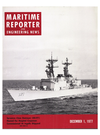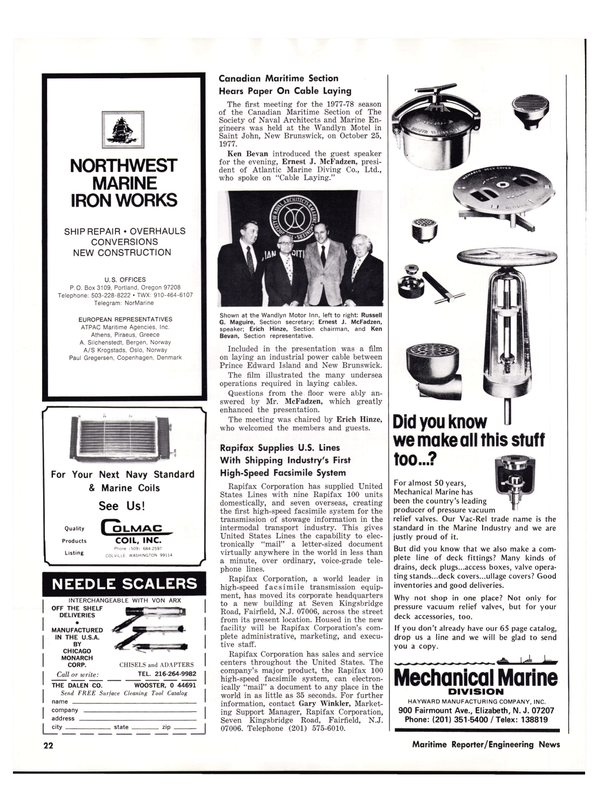
SNAME Pacific Northwest Section Holds Annual Meeting At Harrison Hot Springs, B.C.
The annual meeting of the Pacific Northwest Section of The Society of Naval Architects and Marine Engineers held at "The Harrison," Harrison Hot Springs, British Columbia, Canada, the weekend of October 7-9, was attended by more than 130 members and guests.
The Section was honored to host Robert T. Young, national president of the Society, Mrs.
Young, and the guest speaker at the banquet, the Honorable Jack Davis, Provincial Minister of Energy Transport and Communications.
A buffet/dinner-dance and talent show on Friday evening was enjoyed by all. Door prizes were presented, and the talent show was successfully run by the master of ceremonies, Elijah Horner, vice chairman of the British Columbia Area Section.
On Saturday, the Executive Committee conducted a business meeting over a 7 a.m. breakfast.
Saturday morning's technical session was conducted by the Pacific Northwest Section chairman, who welcomed the Society's national president, Mr. Young. Mr. Young's opening remarks were mainly concerned with the difficulty experienced across the continent in obtaining and training ships crew, especially engineering staff. He stated that the majority of recent marine mishaps were caused by the inexperience of the vessel's personnel, and hoped that this would be remedied by a future program with incentives to attract the right people for a particular crew position. Furthermore, he concluded that a study carried out by a prominent environmental research group indicates the vast majority of the oil polluting the oceans was there through natural causes, such as oil seepage, and that oil tankers were responsible for only 3 percent of the total spills, of which about one-half of 1 percent were structurally related.
Mr. Talbot introduced Dr. Roy F. Hooley, P. Eng., professor, structural engineering, University of British Columbia, who made an excellent presentation of his technical paper entitled "Ship Vibrations." Dr. Hooley discussed and offered solutions to objectionable hull vibrations set up by wave action or, particularly, pulsating machinery and collision impact, both vertical and lateral, which deform the hull to a greater or lesser extent, depending on the type of vessel. He pointed out that in the case of a ship under design, calculations must be accurate and conservative to achieve relatively vibration-free results.
In the case of an existing vessel that has a vibration problem or a vessel that is about to be altered, actual measurements can remove much of the uncertainty and allow a simpler and more accurate calculation. Alleviation of vibration problems was discussed, particularly with respect to tankers, freighters, ferries, and trimarans, with emphasis on the fact that a knowledge of the natural frequencies is necessary to guard against the extreme amplitude of vibrations resulting from resonance.
Summarizing, in most cases it is necessary to have a mathematical model of the ship that will predict mode shapes and frequencies.
If the structural form of the vessel is simple and the beam analogy is applicable, the model can be simple, but as the structural complexity of the vessel grows, the size of the model must grow until a full finite element analysis is required. The properties of this model can then be changed to predict an efficient way of reducing vibrations. If the ship has already been built, field measurements can be taken and the model changed to duplicate them, allowing its use with greater confidence to predict the future behavior of a modified vessel.
Dr. Hooley illustrated his lecture with the use of blackboard, slides, and some very effective, simple, models. Discussers were Paul H. Diehl, Robert B. Grant, and Clair W. Wakefield.
The meeting was attend by 76 members and guests.
A copy of the paper is available from the Section librarian.
With the men busy at the technical session, the wives attended a sherry party in the hospitality suite. Saturday afternoon's recreational activities consisted of a golf tournament, curling bonspiel and bridge, with prizes presented by their respective organizers.
A banquet and dance was held in "Caesar's Forum," preceded by a congenial reception and cocktail hour. The Society president, Mr.
Young, addressed the dinner meeting and presented a certificate of appreciation to Dr. Hooley.
The guest speaker, the Honorable Jack Davis, welcomed the members from the United States, and delivered a timely speech directed toward the impact of the energy crisis on the marine industry.
Mr. Davis outlined the background of events and philosophies leading to international recognition of the general principle of the 200-mile coastal limit. The zones created within the limits come under national jurisdiction as resource management zones, including fishing and mineral exploitation, both on the seabed and under it. Thus Canada, with the second longest coastline in the world, has an enormous responsibility to effectively manage this huge area. Great opportunities exist in both Canada and the United States, particularly for offshore oil and gas exploration and development.
Mr. Davis stressed that marine transportation of crude petroleum is generally the cheapest means of moving oil, with the notable exception of certain pipelines, and that more than 50 percent of ocean tonnage is devoted to oil.
Thus, the impact of worldwide demands for energy will necessarily be reflected in activity in the marine industry. On the West Coast, energy r e q u i r e m e n t s in mid-continent will result in the construction of pipelines, and the effect of these projects, as well as the movement of oil from overseas to West Coast ports to feed into some of these pipelines, will be increased activity in the marine industry.
Mr. Davis concluded on a thoughtful note by stating that the members of the engineering profession are aware of environmental consequences of their work and, in general, respond positively to provide safeguards.
A china teacup and saucer were presented to each of the ladies, and door prizes were drawn, followed by an enjoyable evening of dancing.
Read SNAME Pacific Northwest Section Holds Annual Meeting At Harrison Hot Springs, B.C. in Pdf, Flash or Html5 edition of December 1977 Maritime Reporter
Other stories from December 1977 issue
Content
- Mar Ad Approves Sale Of Tuna Boats To Foreign Companies page: 4
- Eisenbiegler And Rippy Named Presidents Of Two Sun Subsidiaries page: 6
- James S. Byrn Named President Genstar Marine page: 7
- MarAd Contract Let For Development Of Standardized Carrier page: 7
- Bethlehem Steel Sparrows Point Lays Keel For $78-Million Farrell Lines Containership page: 8
- Navy Commissions Ninth Of 30 Destroyers Being Built By Ingalls Shipbuilding page: 8
- SNAME Completes Boiler Safety Report page: 10
- Raytheon Names Millard Commercial Marine Marketing Manager page: 10
- Charles Murphy Receives Halert C. Shepheard Award For Merchant Marine Safety page: 13
- Program Outlined For Annual Conference On Marine Coatings page: 14
- State Boat Awards Contract To Blount For Offshore Supply Boats page: 15
- MarAd Releases Two-Volume Report Prepared By DeLaval page: 15
- SNAME Philadelphia Section Hears Paper On New Flexible Shipbuilding And Ship Repair Facility page: 16
- ARCTEC Canada Limited Opens Testing Facility And Ice Towing Basin page: 17
- Marine Equipment Suppliers Apply For Title XI To Build Self-Propelled Pipelay Ship page: 18
- Strict Liability And Its Impact On Marine Field Discussed By SNAME No. Calif. Section page: 18
- SNAME Pacific Northwest Section Holds Annual Meeting At Harrison Hot Springs, B.C. page: 20
- New Single Point Monitoring Salinity Control System page: 20
- Worthington Announces Management Positions In Marketing And Sales page: 21
- Rapifax Supplies U.S. Lines With Shipping Industry's First High-Speed Facsimile System page: 22
- Mississippi Marine Begins Offshore Boat Construction page: 23
- Series Production Of Aluminum LNG Spheres page: 24
- ICHCA Conference Set For Helsinki May 26-June 1, 1979 page: 26
- Comet Marine Named Marine Distributor By Crane Packing page: 26
- Oceangoing Towing Guidelines Issued By Det Norske Veritas page: 28
- Bird-Johnson Names Darby Sales Engineer For The Gulf Coast page: 28
- Perko Full Line Catalog Just Released page: 29
- Frankel Elected President Of IMODCO page: 30
- CADCOM, Inc. Appoints F. William Helming page: 30
- Seatrain Shipbuilding Appoints Hellenbrecht Chief Marine Engineer page: 31
- ASNE Reports Details Of Recent Symposium On Combat Systems page: 38
- Combustion Engineering Names Robert Fortier page: 38
- Tenneco's Newport News Industrial Corp. (NNI) Appoints M.R. Eshelman page: 41
- Southeast Shipyard Association Elects Fitzgerald President page: 41
- Belcher Tugs To Use Burmeister & Wain Slow Speed Diesels page: 42
- Three Papers Presented At SNAME California Sections Annual Joint Meeting page: 43
- UNITOR Ships Service Holds Dedication Ceremony To Mark Opening Of Facilities In New Jersey page: 44
- Magnus Maritec Names Three To Sales Posts page: 44
- Zapata In Joint Fishing Venture In Costa Rica page: 45
- Sun Ship Forms New Estimating Department —Brawner Named Manager page: 46
- Barney Evans Opens Public Relations Firm page: 47
- Thistle Field Drilling Started By Santa Fe page: 47
- IMODCO Wins Petrobras Contract To Install SPM At Record Depth page: 47
- Second Generation LNG Carriers Subject Of Paper Presented At ASNE Pascagoula Section Meeting page: 49
- Great Lakes/Great Rivers Section Hears Three Technical Papers During Fall Meeting In Ann Arbor page: 52
- Union Mechling's Application For Aid To Build 58 Barges Approved In Principle By MarAd page: 52


